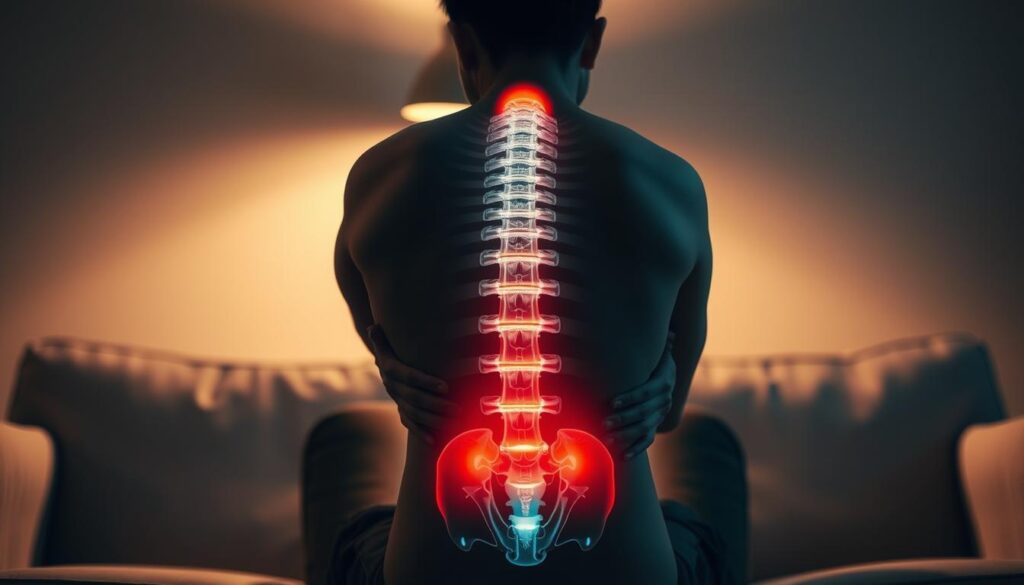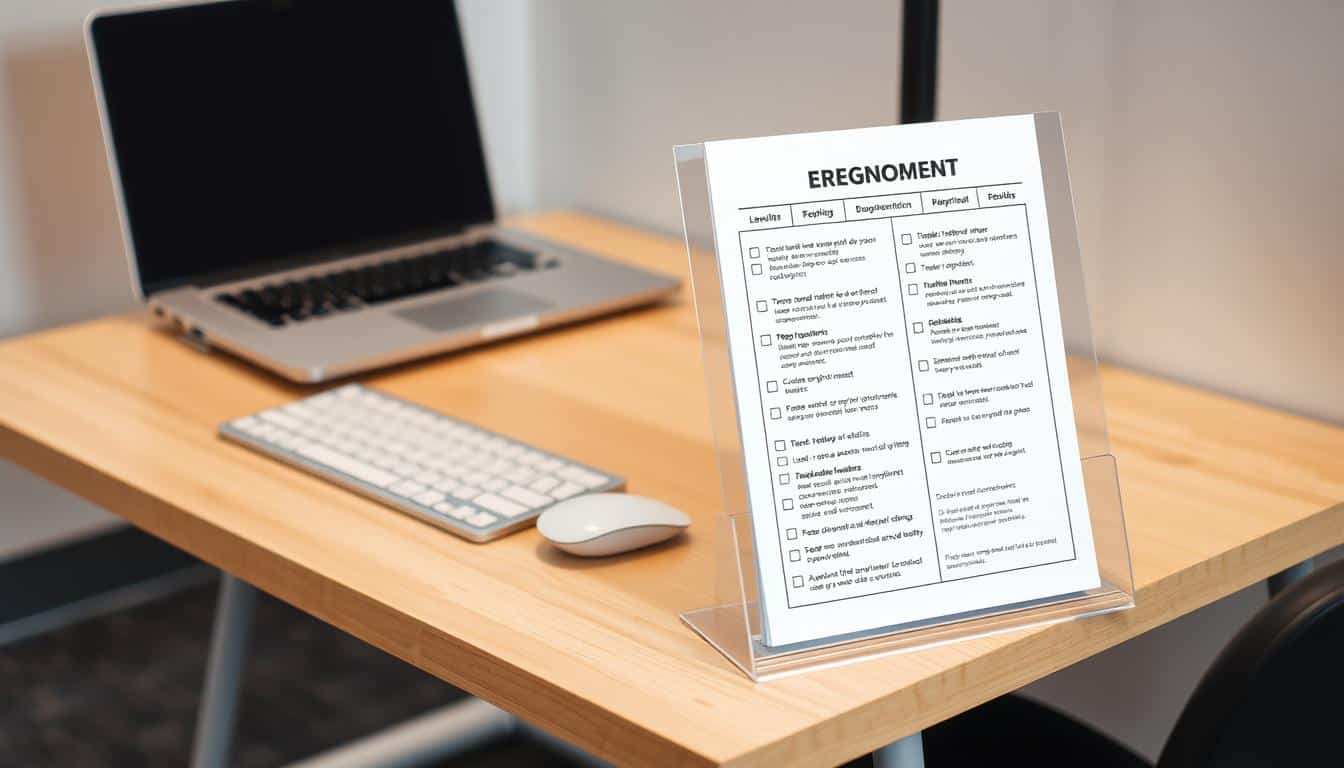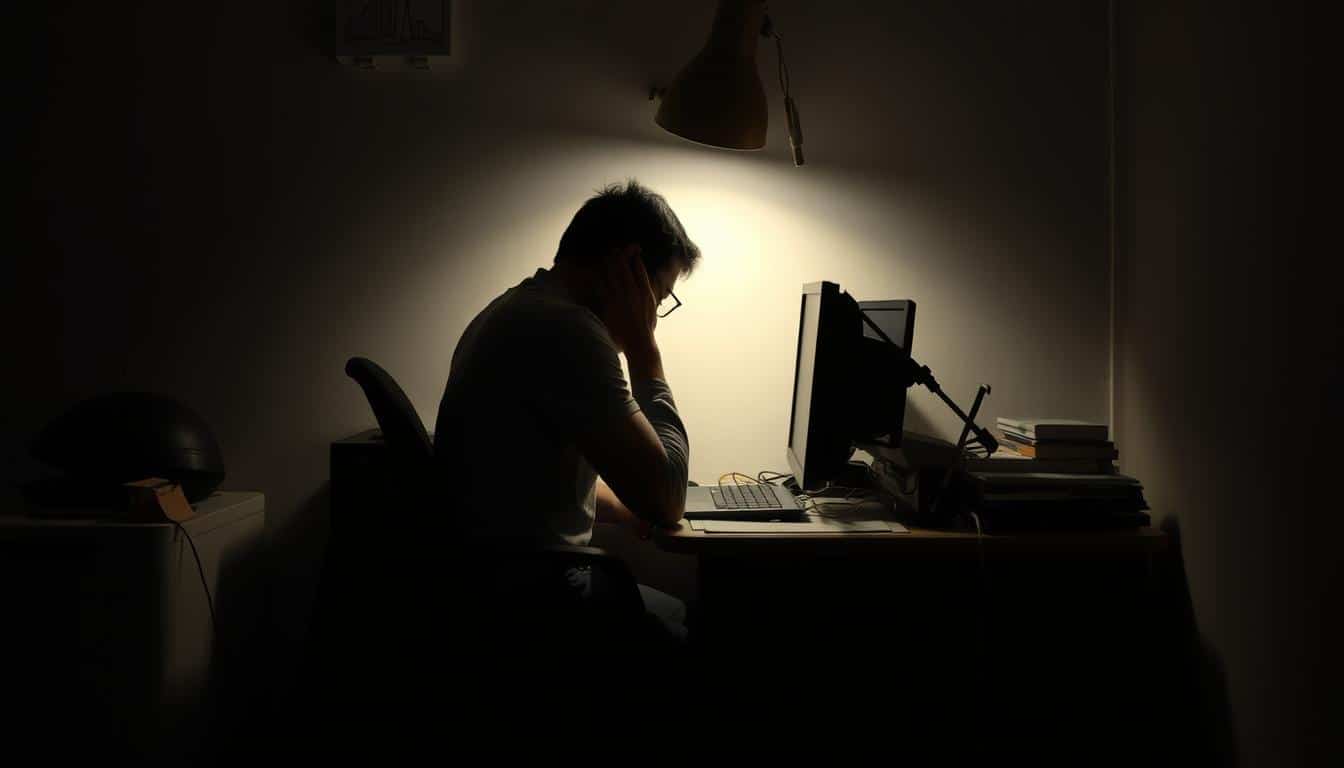Many remote workers feel back pain from working on the sofa. Being comfy at home can make us sit badly and not move much. This often leads to pain or even long-term discomfort. It’s important to know what causes this pain to make a better workspace at home.
Noticing when you’re starting to feel sore can help you deal with back pain from the sofa. Trying for a setup that’s good for your back is key. It helps keep the spine right and makes you feel better overall.
Understanding Back Pain from Sofa Workstation
Understanding back pain from sitting on a sofa requires us to look at a few main reasons. These include sitting too long and bad posture, which can harm your spine. If you sit on a sofa, you might not get enough support for your lower back. This support is key to keep your spine aligned right.
If your spine isn’t supported well, its natural shape might change. This can make back pain worse. To manage this pain while working from a sofa, it’s important to spot bad posture early. Then, you can make changes to support your back better. Making the right changes can really help you feel better. It cuts down on the back pain that comes from a poor setup.

Why Prolonged Sitting Worsens Back Pain
Sitting too long can make back pain worse. Staying still for too long makes muscles stiff and tired. A 2021 study showed that sitting a lot makes it 42% more likely to get lower back pain. This is because sitting wrong puts extra load on your spine, hurting muscles and bones.
Bad sitting habits, like slouching on a couch, weaken your core. Taking breaks and changing your position helps fight this. Knowing the risks of sitting too much is key to avoiding back pain.
Common Causes of Back Pain from Sofa Workstation
Working from a sofa brings different factors that cause back pain. Understanding them helps find effective solutions. We’ll look into issues like postural stress, spinal disc compression, and muscle imbalances that lead to discomfort.
Postural Stress
Bad sitting habits, such as slouching or leaning forward, add stress to the spine. This stress affects muscles, ligaments, and joints, leading to discomfort. Improving posture is key to reducing pain from long periods of sitting on a sofa.
Spinal Disc Compression
Sitting for a long time increases pressure on the spinal discs. This can make conditions like herniated discs worse. The upper body’s weight, along with bad posture, puts extra stress on the lower back.
Muscle Imbalances
Sitting too much can make hip flexors tight and weaken core muscles. These issues harm posture and can cause lower back discomfort. Doing specific stretches and exercises helps fix these problems and improve spinal health.
How to Sit on a Sofa with Good Posture
Sitting properly on a comfortable sofa is key for your comfort and for keeping your spine healthy. Knowing how to keep your body aligned helps a lot in avoiding back pain. This is especially true if you sit for a long time. Let’s dive into two key habits you should follow to enjoy your sofa time.
Check Body Alignment
Your back needs to be straight, and your shoulders should feel relaxed when you’re sitting at the sofa’s edge. Adding a cushion or some lumbar support behind your lower back helps keep your spine in a good position. This is important for a healthy spine, especially if you’re sitting for work.
Maintain Good Angles for Knees and Hips
It’s crucial to keep your knees bent at a right angle and your feet flat on the floor. This not only keeps you balanced but also stops one side of your body from being more stressed than the other. Paying attention to this when you sit on an ergonomic sofa really makes sitting much better.
Effective Tips to Reduce Back Pain while Working from Home
Working from home gives us freedom. But without the right setup, we might feel aches and back pain. By applying some smart strategies, we can cut down on the pain. Here are ergonomic tips to help:
- Take regular breaks every 30 minutes to stand up and stretch. Moving around eases tension.
- Incorporate light stretches or short walks to enhance circulation and promote home office pain relief.
- Switch between sitting and standing using a standing desk. This helps reduce back strain.
- Make sure your work area supports a comfy posture. Proper setup can ease back pain.
- Look at your chair. A chair with good lower back support is key.
Enhancing Your Workspace Ergonomics
Having a supportive workspace improves comfort and how much you get done. Focusing on ergonomics brings big benefits if you sit a lot. It’s key to get a good chair and to set up your desk the right way.
Investing in an Ergonomic Chair
An ergonomic chair is vital for a great work area. It adjusts to fit you perfectly, including back support for the right posture. Sitting straight helps lessen pain and boosts your concentration and work performance.
Setting Up Your Desk Properly
Your desk setup is also super important for ergonomics. Make sure your elbows can bend at 90 degrees when you’re typing. Also, your screen should be at eye level to avoid neck pain. Changing things up as needed can make your desk setup perfect for working many hours.
Active Solutions: Movement and Exercise
Moving around every day is key to fighting off back pain. By being active, you cut down the chance of hurting from sitting too much. Learning about things like taking regular breaks and doing special exercises can make your back stronger and more comfortable.
Scheduling Regular Breaks
Make a plan to get up or stretch every 30 to 60 minutes to fight the downsides of sitting all day. Taking quick breaks to move helps your blood flow better, eases muscle tension, and is good for staying active. These moments also fix your posture, stopping back pain before it starts.
Targeted Back Exercises
Adding certain exercises to your routine can make your back stronger and more flexible. Moves like the Cat Cow stretch or twisting your lower back are great because they stretch and strengthen at the same time. Doing these regularly helps keep your back in good shape and prevents pain in the long run.
Preventing Back Pain from Sofa Workstation
Being proactive is key to avoiding back pain at a sofa workstation. Making simple tweaks to how you sit and adding support for your lower back are essential. These steps create a workspace that’s both cozy and supportive.
Adjusting Your Sofa Setup
Small changes to your sofa can make a big difference in how you feel. Here are some tips to make your seat more comfortable:
- Add cushions to improve your posture and give the support you need.
- Your feet should touch the ground while your knees form a right angle.
- Sit with your back straight against the sofa for better spine alignment.
Using Lumbar Support
Lumbar support is super important. Using a cushion or pillow for your lower back can align it properly. This helps with:
- Better posture and less muscle strain.
- Staying comfortable even if you sit for a long time, reducing back pain.
- Promoting a healthy spine shape, crucial for avoiding back issues in the future.
When to Seek Professional Help
Knowing when to seek professional help for back pain is key. If discomfort lasts more than a week, see a healthcare provider soon. Don’t ignore the symptoms of back pain as it could get worse.
Look out for signs that suggest more serious issues. These signs include:
- Leg weakness or numbness
- Changes in bowel or bladder function
- Uncontrolled pain that doesn’t get better with home care
Talking to a professional can give you important advice for your condition. Getting help early can improve your chances of getting better and target the true reasons for your back pain.
Mindful Practices to Address Back Pain
Adding mindfulness to your daily routine can really help with back pain. Techniques like meditation and yoga are great for easing stress. They help quiet the mind and make physical pain less sharp.
Deep breathing is also very helpful. It lets you relax and might lessen muscle tension around your spine. Imagine peaceful scenes to help deal with pain better, giving you more control over how you feel.
Regular mindfulness practices improve both your mind and body health. This whole-person care helps you handle back pain better over time. By adding these methods to your life, you’ll find longer-lasting relief and enjoy life more.
Conclusion
Dealing with back pain at a sofa workstation requires several steps. This includes making ergonomic changes, moving more, and practicing mindfulness. How we sit and arrange our work area greatly affects our back health. People can make their home offices better for their backs by understanding this.
Fixing back pain means adjusting how you sit, getting good back support, and doing certain exercises. These steps improve comfort and make you more productive at home.
To lessen back pain, focus on ergonomic changes and add movement to your day. These efforts make working from home better and healthier. By taking these steps, you’ll enjoy a more comfy and effective work-from-home setup.



